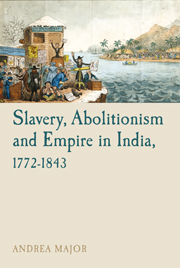Book contents
- Frontmatter
- Contents
- List of Illustrations
- Acknowledgements
- List of Abbreviations
- Glossary
- Some Prominent Figures in the British Parliament, the Abolitionist Movement and the East India Company
- Part I Other Slaveries
- Part II European Slaveries
- Introduction: Slavery and Colonial Expansion in India
- 2 ‘A Shameful and Ruinous Trade’: European Slave-trafficking and the East India Company
- 3 Bengalis, Caffrees and Malays: European Slave-holding and Early Colonial Society
- Part III Indian Slaveries
- Part IV Imagined Slaveries
- Conclusion: ‘Do Justice to India’: Abolitionists and Indian Slavery, 1839–1843
- Select Bibliography
- Index
Introduction: Slavery and Colonial Expansion in India
from Part II - European Slaveries
- Frontmatter
- Contents
- List of Illustrations
- Acknowledgements
- List of Abbreviations
- Glossary
- Some Prominent Figures in the British Parliament, the Abolitionist Movement and the East India Company
- Part I Other Slaveries
- Part II European Slaveries
- Introduction: Slavery and Colonial Expansion in India
- 2 ‘A Shameful and Ruinous Trade’: European Slave-trafficking and the East India Company
- 3 Bengalis, Caffrees and Malays: European Slave-holding and Early Colonial Society
- Part III Indian Slaveries
- Part IV Imagined Slaveries
- Conclusion: ‘Do Justice to India’: Abolitionists and Indian Slavery, 1839–1843
- Select Bibliography
- Index
Summary
In December 1771, a man named James Somerset was confined in irons on board the Anne and Mary, a ship then anchored in the Thames. Somerset, who had been a slave in Virginia and Massachusetts, came to England with his master, Charles Stewart, in 1769. After absconding from Stewart's service, he was recaptured in November 1771 and, on refusing to return to his master's service, handed over for transportation to Jamaica, to be resold into slavery. Fortunately for Somerset, his plight caught the attention of anti-slavery leaders John Marlow, Thomas Walkin and Elizabeth Cade, who, with the help of Granville Sharp, petitioned the Chief Justice Lord Mansfield for a writ of habeas corpus to release him. The case that followed represented a landmark in the history of British attitudes to slavery, because when Lord Mansfield announced his verdict in June 1772 he found that, because enslavement could not exist without a positive law to uphold it, it could not be enforced in Britain. The precise implications of Mansfield's decision are contested; some historians see it as marking the abolition of slavery in the metropole, while others argue that its significance has been exaggerated, because de facto slavery continued after this date. Whether it materially altered the conditions of servitude for Africans and Asians in Britain, Mansfield's decision did formalise emerging assumptions that slavery was incompatible with British subjecthood.
- Type
- Chapter
- Information
- Slavery, Abolitionism and Empire in India, 1772–1843 , pp. 41 - 48Publisher: Liverpool University PressPrint publication year: 2012

